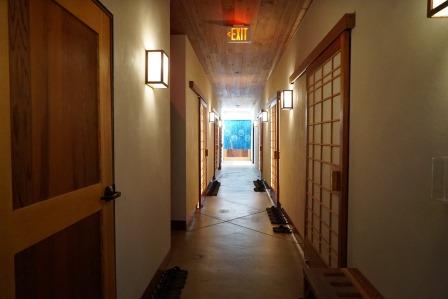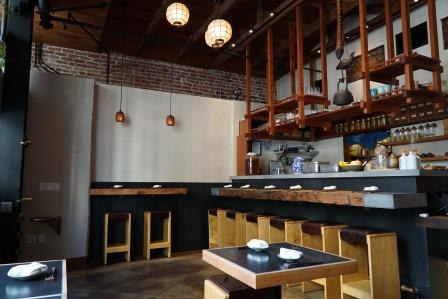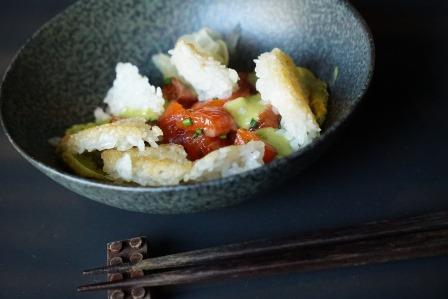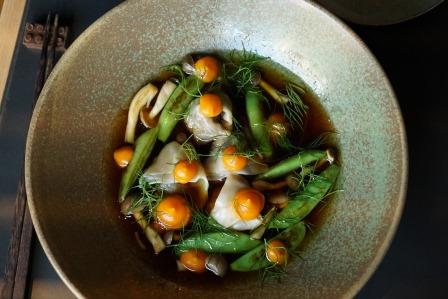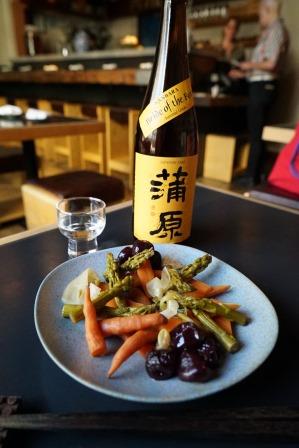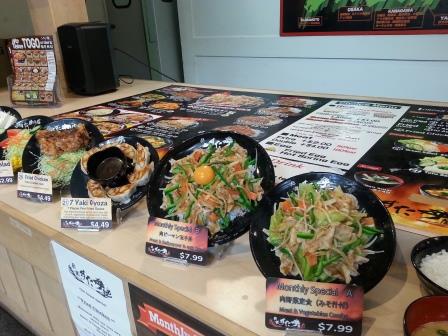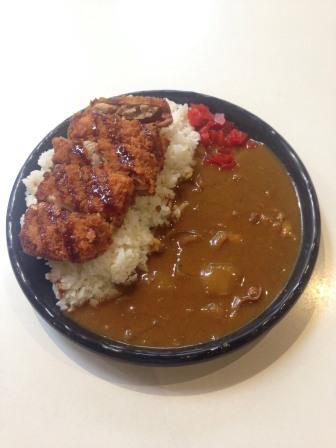A restaurant that fully reflects Japanese “Bath House Culture” opens
By Elli Sekine
In San Francisco where the restaurant business is becoming more and more diversified, a restaurant facility called “Onsen” that combines a bath house and a restaurant made its debut at the end of last year. This restaurant that took 3 years to build, replicating and beautifully modernizing the traditional Japanese bath house (sentoh), unifying a bar and a restaurant, is the talk of the town for its unique and unprecedented concept in the US.
Sunny Simmons and Caroline Smith, the owners of this restaurant facility are a married couple who love Japan very much. Among many Japanese cultures, they have been particularly charmed by hot springs and bath houses. They wanted to spread the “Japanese bath house culture”, the true essence of relaxation, to the US, and opened this facility. The place looks like nothing but a restaurant if you only look at the entrance, but as you go deeper inside the space, a new world opens up. You can use their bath or the spa facility alone, or the bar and the restaurant space also individually. In San Francisco, where there are many people who love Japanese culture, people are talking highly about the experience that they can truly enjoy through having drinks and healthy Japanese dishes after soaking themselves in the Japanese bath.
The Tenderloin District in the west of downtown, where this facility is located, used to be unstable with public safety, and had a far from trendy image, but stylish bars and restaurants are slowly coming to the area in recent years. The Onsen’s sophisticated look has definitely refreshed the surrounding scenery. The owner/architecture designer Sunny explains why this location was chosen. “This redbrick building inspired my designer spirit to create an ideal facility.” The building is deep inside, and the space was suitable for building a bath house. It is not very close to the nearby train station, and there is not much foot traffic either, but it is close enough from the downtown area, so tourists come by Uber from hotels, and many neighboring people also come. A parking lot is also available across the street. For the Americans who love to experience Japanese culture, this is an innovative facility where they can enjoy having meals while visiting a spa or a yoga studio-like place instead of going to equivalent facilities in hotels.
Its modern Japanese-flavored interior space designed by Sunny draws your attention immediately after entering. The artistic space themed with an old Japanese-style house is full of old household tools such as an old fire place and an accompanying hanging hook, a tea ceremony set, a traditional iron kettle, etc. You can sense his love of Japan. When you walk deeper into the space, you reach the entrance of the “Sentoh (bath house)”, his masterpiece.
There is a long quaint corridor, and you see a massage service room, a tatami banquet room, and a locker room on the way to the entrance door. You find comfortable cotton robes made in Japan in the locker room for you to change into to go to the bath house. The sophisticated looking elegant bath house has a high ceiling from where the sunlight comes in, a lot of green plants cascading from the walls, and is creating a beautiful contrast with the settling red bricks. You can spend very relaxed happy moments going into the steam room, dry sauna, etc. in the facility equipped with a shower room and TOTO-brand toilets.
The dining room is rather small with a counter bar, 4 tables and 16 seats, but they have an extensive drink menu with cocktails, beers, wine, and sake. For health-conscious customers, there is a rich collection of teas including konbu tea, herb tea, Pu-erh tea, matcha, and even gyokuro tea. Their new-age Japanese dishes are created by Chef George Meza who has worked at high-end Japanese restaurants like “Ame” and “Terra”. His dishes are creative using Californian ingredients while retaining the standard skills, lightly-flavored, yet satisfyingly rich. The beautiful presentation of the dishes using herbs is highly acclaimed as well.
The popular dishes include “Mushroom dumplings” ($16) cooked in dried bonito-base dashi, citrus, and oil, served with beautifully decorated local vegetables, 5 kinds of juicy yakitori with vegetable skewers, and ginger-base dashi udon noodles with spicy miso ($13). Each dish is made small in quantity suitable to accompany sake and beer drinking.
There are plenty of spas in San Francisco, and as the pioneers of Japanese style bath houses out of highend hotels, there are “Kabuki Spa”, etc. However, “Onsen” is the only place that is combined with a restaurant, and started to attract the attention of curious restaurant side clientele who don’t know what the bath house is. On the other hand, at American homes, installing of Japanese style bath tubs and washlets are slowly but steadily increasing. I hope that the Japanese bath culture that provides ultimate relaxation will spread, triggered by this debut of “Onsen” restaurant.
日本の“風呂文化”を駆使したレストラン施設がオープン
日本食レストランの多様化が進むサンフランシスコで、「Onsen」という名前のお風呂+レストラン施設が去年の暮れ登場した。3 年の工事期間を経てオープンした同店は、日本の伝統文化である“ 銭湯” を美しくモダンに再現し、バーとレストランを融合させた全米でも類を見ない新しいコンセプトで話題を呼んでいる。
オーナーのサニー・シモンズ氏とキャロライン・スミス氏は日本をこよなく愛すご夫婦。日本文化の中でも特に温泉や銭湯に惹きつけられ、リラクゼーションの真髄である日本の「風呂文化」をアメリカにも広げたいと、オープンしたのがこの施設。エントランスからは一見普通のレストランに見えるが、奥に進むと別世界が広がっている。お風呂やスパ施設は単独でも利用でき、バー、レストランは常時利用できる。親日家が多いサンフランンシスコで、お風呂に浸かった後のドリンクや健康的な日本食メニューは最高だという声がすでに聞かれている。
同店が位置するダウンタウンの西側、テンダーロイン地区は長年不安定な治安でトレンディとは無縁だったが、近年この周辺におしゃれなバーやレストランが少しずつ増えている。その中で「Onsen」の洗練された外観は周りの風景を一新している。この場所を選んだ理由ついて、「理想の施設を創造するのにデザインスピリットを掻き立てられる(赤煉瓦の)ビルだった」とオーナーで建築デザイナーのサニー氏。建物は奥行きが広く、風呂施設を建設するのに適していた。駅からは少し離れ人通りは少ないが、ダウンタウンから近いのでホテルからUberなどを利用する観光客や地元客が多い。向かいには駐車場もある。日本文化が好きなアメリカ人にとっては、ホテルの施設より身近にスパかヨガに行く感覚で食事も楽しめる画期的な施設だ。
店内に入った瞬間惹きつけられるインテリアは、サニー 氏がデザインしたモダンな和テイスト空間。古民家を意識した空間美術は、囲炉裏に付随する火棚吊り棒や茶道具、伝統的な鉄瓶などの古民具が散りばめられ、彼のセンスと日本への愛情が感じられる。奥に進むと彼のマスターピースとなる“ 銭湯” への入り口がある。そのドアまで続く風情がある長い廊下には、鍼やマッサージのサービスが受けれる個室、宴会ができる畳の個室がある。風呂場の前にあるロッカールームには、着心地の良い日本製の綿浴衣が常備され、それを着て風呂場に入る。洗練された優雅な雰囲気の風呂場は、高い天井から陽光が差し込み、緑が滝のように垂れ、落ちついた赤煉瓦とのコントラストが美しい。スティームルーム、ドライサウナの他、シャワールーム、TOTO製トイレが設備され、快適でリラックスした至福の時が過ごせる。
ダイニングルームはカウンターバー7席と 4テーブル14 席とこじんまりしている。しかしドリンクメニューは、カクテル、ビール、ワイン、酒と健康志向のメニューにはコンブ茶、ハーブティーからプアティー、抹茶、玉露までを揃えている。新感覚の日本食を担うのは、元高級日本食レストラン「Ame」や「Terra」での経験を持つシェフ、ジョージ・メザ氏。彼の独創的な料理は、基本を保ちながらもカリフォルニアの食材を用いライトなのに味がしっかりして食べ応えがある。緑のハーブを添えた美しいプレゼンも定評がある。人気は、鰹節でとった出汁に酸味やオイルを加え、地元の野菜を彩りよく添えたマッシュルームダンプリング($16)、野菜を含めた5種類のジューシーな焼き鳥、ジンジャー出汁のうどん辛味噌添え($13)など。お酒やビールに合う小さなメニュー構成だ。
サンフランシスコには現在スパ施設は多いが、高級ホテル外で、日本的な風呂施設の先駆けとして「Kabuki Spa」などがある。しかしレストランを併設する「Onsen」は随一で、風呂を知らない人もレストランを訪れた際興味を持ち始めている。「Onsen」の登場が引き金となり究極の安らぎを与える風呂文化の普及に期待したい。
Onsen
466 Eddy St.
San Francisco, CA 94109
(415) 441-4987
https://www.onsensf.com/
Bath:
Mon, Wed 3:30pm-10:00pm
Thu 11:00am-10:00pm
Fri 12:00pm-11:00pm
Sat, Sun 10:30 am-11:00pm
Restaurant:
Wed-Thur 5:30pm-9:30pm
Fri-Sun 5:30pm-10:00pm
Mon-Tue closed
In San Francisco where the restaurant business is becoming more and more diversified, a restaurant facility called “Onsen” that combines a bath house and a restaurant made its debut at the end of last year. This restaurant that took 3 years to build, replicating and beautifully modernizing the traditional Japanese bath house (sentoh), unifying a bar and a restaurant, is the talk of the town for its unique and unprecedented concept in the US.
Sunny Simmons and Caroline Smith, the owners of this restaurant facility are a married couple who love Japan very much. Among many Japanese cultures, they have been particularly charmed by hot springs and bath houses. They wanted to spread the “Japanese bath house culture”, the true essence of relaxation, to the US, and opened this facility. The place looks like nothing but a restaurant if you only look at the entrance, but as you go deeper inside the space, a new world opens up. You can use their bath or the spa facility alone, or the bar and the restaurant space also individually. In San Francisco, where there are many people who love Japanese culture, people are talking highly about the experience that they can truly enjoy through having drinks and healthy Japanese dishes after soaking themselves in the Japanese bath.
The Tenderloin District in the west of downtown, where this facility is located, used to be unstable with public safety, and had a far from trendy image, but stylish bars and restaurants are slowly coming to the area in recent years. The Onsen’s sophisticated look has definitely refreshed the surrounding scenery. The owner/architecture designer Sunny explains why this location was chosen. “This redbrick building inspired my designer spirit to create an ideal facility.” The building is deep inside, and the space was suitable for building a bath house. It is not very close to the nearby train station, and there is not much foot traffic either, but it is close enough from the downtown area, so tourists come by Uber from hotels, and many neighboring people also come. A parking lot is also available across the street. For the Americans who love to experience Japanese culture, this is an innovative facility where they can enjoy having meals while visiting a spa or a yoga studio-like place instead of going to equivalent facilities in hotels.
Its modern Japanese-flavored interior space designed by Sunny draws your attention immediately after entering. The artistic space themed with an old Japanese-style house is full of old household tools such as an old fire place and an accompanying hanging hook, a tea ceremony set, a traditional iron kettle, etc. You can sense his love of Japan. When you walk deeper into the space, you reach the entrance of the “Sentoh (bath house)”, his masterpiece.
There is a long quaint corridor, and you see a massage service room, a tatami banquet room, and a locker room on the way to the entrance door. You find comfortable cotton robes made in Japan in the locker room for you to change into to go to the bath house. The sophisticated looking elegant bath house has a high ceiling from where the sunlight comes in, a lot of green plants cascading from the walls, and is creating a beautiful contrast with the settling red bricks. You can spend very relaxed happy moments going into the steam room, dry sauna, etc. in the facility equipped with a shower room and TOTO-brand toilets.
The dining room is rather small with a counter bar, 4 tables and 16 seats, but they have an extensive drink menu with cocktails, beers, wine, and sake. For health-conscious customers, there is a rich collection of teas including konbu tea, herb tea, Pu-erh tea, matcha, and even gyokuro tea. Their new-age Japanese dishes are created by Chef George Meza who has worked at high-end Japanese restaurants like “Ame” and “Terra”. His dishes are creative using Californian ingredients while retaining the standard skills, lightly-flavored, yet satisfyingly rich. The beautiful presentation of the dishes using herbs is highly acclaimed as well.
The popular dishes include “Mushroom dumplings” ($16) cooked in dried bonito-base dashi, citrus, and oil, served with beautifully decorated local vegetables, 5 kinds of juicy yakitori with vegetable skewers, and ginger-base dashi udon noodles with spicy miso ($13). Each dish is made small in quantity suitable to accompany sake and beer drinking.
There are plenty of spas in San Francisco, and as the pioneers of Japanese style bath houses out of highend hotels, there are “Kabuki Spa”, etc. However, “Onsen” is the only place that is combined with a restaurant, and started to attract the attention of curious restaurant side clientele who don’t know what the bath house is. On the other hand, at American homes, installing of Japanese style bath tubs and washlets are slowly but steadily increasing. I hope that the Japanese bath culture that provides ultimate relaxation will spread, triggered by this debut of “Onsen” restaurant.
日本の“風呂文化”を駆使したレストラン施設がオープン
日本食レストランの多様化が進むサンフランシスコで、「Onsen」という名前のお風呂+レストラン施設が去年の暮れ登場した。3 年の工事期間を経てオープンした同店は、日本の伝統文化である“ 銭湯” を美しくモダンに再現し、バーとレストランを融合させた全米でも類を見ない新しいコンセプトで話題を呼んでいる。
オーナーのサニー・シモンズ氏とキャロライン・スミス氏は日本をこよなく愛すご夫婦。日本文化の中でも特に温泉や銭湯に惹きつけられ、リラクゼーションの真髄である日本の「風呂文化」をアメリカにも広げたいと、オープンしたのがこの施設。エントランスからは一見普通のレストランに見えるが、奥に進むと別世界が広がっている。お風呂やスパ施設は単独でも利用でき、バー、レストランは常時利用できる。親日家が多いサンフランンシスコで、お風呂に浸かった後のドリンクや健康的な日本食メニューは最高だという声がすでに聞かれている。
同店が位置するダウンタウンの西側、テンダーロイン地区は長年不安定な治安でトレンディとは無縁だったが、近年この周辺におしゃれなバーやレストランが少しずつ増えている。その中で「Onsen」の洗練された外観は周りの風景を一新している。この場所を選んだ理由ついて、「理想の施設を創造するのにデザインスピリットを掻き立てられる(赤煉瓦の)ビルだった」とオーナーで建築デザイナーのサニー氏。建物は奥行きが広く、風呂施設を建設するのに適していた。駅からは少し離れ人通りは少ないが、ダウンタウンから近いのでホテルからUberなどを利用する観光客や地元客が多い。向かいには駐車場もある。日本文化が好きなアメリカ人にとっては、ホテルの施設より身近にスパかヨガに行く感覚で食事も楽しめる画期的な施設だ。
店内に入った瞬間惹きつけられるインテリアは、サニー 氏がデザインしたモダンな和テイスト空間。古民家を意識した空間美術は、囲炉裏に付随する火棚吊り棒や茶道具、伝統的な鉄瓶などの古民具が散りばめられ、彼のセンスと日本への愛情が感じられる。奥に進むと彼のマスターピースとなる“ 銭湯” への入り口がある。そのドアまで続く風情がある長い廊下には、鍼やマッサージのサービスが受けれる個室、宴会ができる畳の個室がある。風呂場の前にあるロッカールームには、着心地の良い日本製の綿浴衣が常備され、それを着て風呂場に入る。洗練された優雅な雰囲気の風呂場は、高い天井から陽光が差し込み、緑が滝のように垂れ、落ちついた赤煉瓦とのコントラストが美しい。スティームルーム、ドライサウナの他、シャワールーム、TOTO製トイレが設備され、快適でリラックスした至福の時が過ごせる。
ダイニングルームはカウンターバー7席と 4テーブル14 席とこじんまりしている。しかしドリンクメニューは、カクテル、ビール、ワイン、酒と健康志向のメニューにはコンブ茶、ハーブティーからプアティー、抹茶、玉露までを揃えている。新感覚の日本食を担うのは、元高級日本食レストラン「Ame」や「Terra」での経験を持つシェフ、ジョージ・メザ氏。彼の独創的な料理は、基本を保ちながらもカリフォルニアの食材を用いライトなのに味がしっかりして食べ応えがある。緑のハーブを添えた美しいプレゼンも定評がある。人気は、鰹節でとった出汁に酸味やオイルを加え、地元の野菜を彩りよく添えたマッシュルームダンプリング($16)、野菜を含めた5種類のジューシーな焼き鳥、ジンジャー出汁のうどん辛味噌添え($13)など。お酒やビールに合う小さなメニュー構成だ。
サンフランシスコには現在スパ施設は多いが、高級ホテル外で、日本的な風呂施設の先駆けとして「Kabuki Spa」などがある。しかしレストランを併設する「Onsen」は随一で、風呂を知らない人もレストランを訪れた際興味を持ち始めている。「Onsen」の登場が引き金となり究極の安らぎを与える風呂文化の普及に期待したい。
Onsen
466 Eddy St.
San Francisco, CA 94109
(415) 441-4987
https://www.onsensf.com/
Bath:
Mon, Wed 3:30pm-10:00pm
Thu 11:00am-10:00pm
Fri 12:00pm-11:00pm
Sat, Sun 10:30 am-11:00pm
Restaurant:
Wed-Thur 5:30pm-9:30pm
Fri-Sun 5:30pm-10:00pm
Mon-Tue closed








